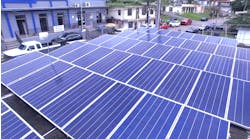Two pioneering players in Africa’s fast-emerging, distributed solar energy industry are working together with the aim of funding off-grid, solar-storage microgrids across rural Kenya and Sub-Saharan Africa over the next five years.
Backed with capital from Caterpillar Ventures, First Solar and the Leonardo di Caprio Foundation, Berkeley, California and Nairobi, Kenya-based Powerhive has built, owns and operates 20 rural, off-grid, solar-storage microgrids that serve some 20,000 people, primarily in Kenya’s Kisii County. It was the first privately owned company in Kenya to obtain a license to operate a power utility.
Sun Exchange is a blockchain-based and micro-funding platform that aims to do for distributed solar energy what cryptocurrencies are doing in banking and finance — democratize and open up access to products, services and markets to all comers, founder and CEO Abraham Cambridge told Microgrid Knowledge.
Sun Exchange expects to raise as much as $88 million via an initial coin offering (ICO) of SUNEX digital rewards tokens that’s running through year-end. As much as $23 million will be invested to “pre-finance” installation of as many as 150 new Powerhive rural microgrids projected to serve as many as 175,000 rural villagers who lack grid access. Subsequently, those will be refinanced by opening them up to Solar Exchange community members for investment, Cambridge explained.
Crowdfunding solar-storage microgrids
Cambridge says that Sun Exchange can raise capital for companies like Powerhive much faster than conventional financiers and often at lower cost.
“Just as cryptocurrencies are re-leveling the playing field and opening up opportunities in under- and undeveloped banking and financial services markets, we’re doing so in the electricity sector,” he said. “Projects such as those Powerhive is developing are a very good match with our platform and the interests of our community members.”
All told, the “pre-financed” Powerhive microgrids slated for listing on Sun Exchange will have the capacity to power about 175,000 rural villagers at a cost equal to or less than that they’re paying for kerosene, charcoal, firewood and other traditional fuel sources, said Chris Hornor, founder and CEO of Powerhive.
“Originally, we were looking at doing an ICO ourselves, but we decided to partner with someone that’s already doing one so that each partner could leverage their respective areas of expertise. For our part, that’s building, owning and operating community microgrids at scale in rural Kenya. We’re one of the few companies that actually has a pipeline of projects in-country generating cash flows. That gives investors an added level of comfort,” Hornor said.
Sales and installations of mobile pay-go home solar systems has been growing rapidly in Kenya and across East Africa, giving rise to ambitious rural electrification drives. Solar-storage microgrids are a more efficient way of achieving the same goals, which helps keep costs low and service quality high, according to Hornor.
“The difference between what we’re doing and installation of home solar energy kits and services is that we’re providing a larger scale, standardized, utility aspect to distributed solar electrification. Our microgrids enable us to generate a lot more solar energy and distribute that energy more efficiently, sharing it across many more customers,” Hornor said.
Powerhive also helps rural villagers leverage electricity from the microgrids. The start-up runs so-called wealth generation programs, such as the solar-powered chicken incubation initiative ‘Kuku Poa.’ Leveraging solar power for productive purposes fuels a self-sustaining, virtuous circle of healthy, socioeconomic development, Powerhive says. It also helps raise customers’ incomes, enhancing their ability to pay for electricity.
Why this partnership
Funding projects that are already operating marks a significant point of departure for Sun Exchange. Up to this point, it has raised capital from digital community members for distributed solar installations yet to be built.
Several factors led Sun Exchange to enlist Powerhive as a pre-finance solar project developer. Feedback from investment community members was one. Sun Exchange members cited solar-powered microgrids as their preferred type of solar energy investment by a margin of around 3-1 in a recent company survey, Cambridge noted.
Powerhive’s proven success in developing,owning and operating community solar-storage microgrids in Kenya was another. “They [Powerhive] have one of the most advanced, sophisticated and field-tested approaches to distributed solar microgrid project development out there, and it’s a very powerful human story as well,” Cambridge said.
That approach includes a highly automated, standardized process that extends from project siting and microgrid systems design and engineering to energy services provision, operations, billing and payments administration, and maintenance. “They can roll out projects incredibly fast. All they need is the capital to keep up,” Cambridge said.
Sun Exchange has nearly completed the vetting and due diligence it undertakes before deciding to list projects on its members-only crowdfunding platform. To kick things off, management has narrowed down Powerhive’s 20 existing community solar microgrids to a final four. One will be chosen in the next month or two to inaugurate Powerhive and pre-financed project funding on Sun Exchange.
“We’ve visited the sites, looked at the assets, done site inspections, met with customers, on-site engineers and operations staff. It’s all looking good so far, which is why we agreed to work with them through our token sale,” Cambridge said. “The proceeds are going to be used to directly finance solar-powered, community microgrids.
Track news about solar-storage microgrids in Africa. Subscribe to the free Microgrid Knowledge newsletter.







